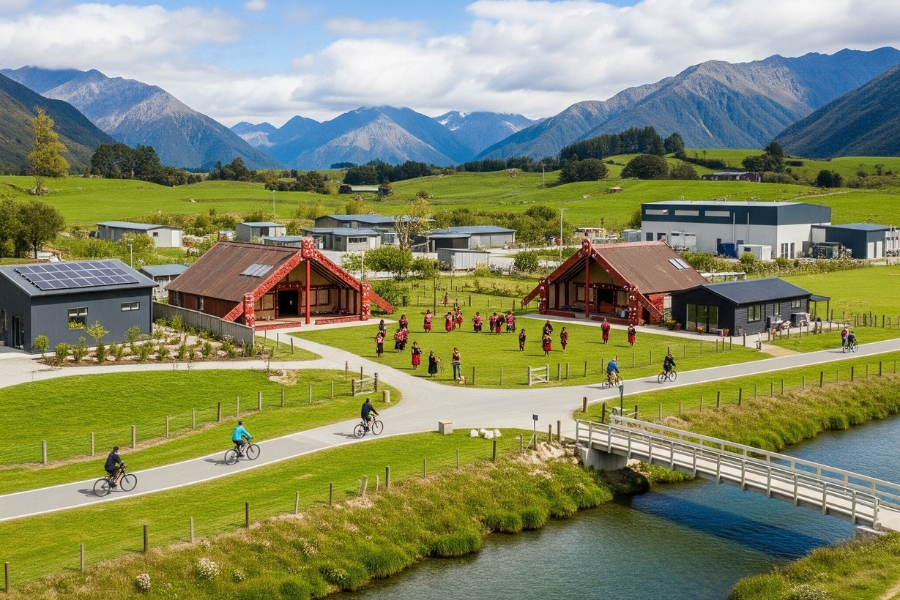EDITORIAL: The Tourism Infrastructure Fund: A Legacy of Balance in New Zealand’s Tourism Boom

New Zealand’s tourism industry, a jewel in the nation’s economic crown, has long drawn millions to its rugged coastlines, soaring mountains, and vibrant cultural tapestry. Yet, the influx of visitors—peaking before the COVID-19 pandemic—strained the infrastructure of small communities, where public toilets, carparks, and waste systems groaned under the weight of seasonal crowds. In 2017, the Tourism Infrastructure Fund (TIF) emerged as a bold response, channelling over $106 million into public amenities across seven funding rounds until its quiet closure in 2023. As the fund fades from public discourse, its legacy offers lessons in balancing tourism’s benefits with its burdens, a challenge that remains as pressing as ever.
A Fund Born of Necessity
Launched in May 2017 by the National Government with a $102 million budget, the TIF was a lifeline for councils grappling with tourism’s hidden costs. Small towns like Franz Josef, Hanmer Springs, and Matapōuri, with limited ratepayer bases, faced disproportionate pressure from visitor numbers. Public facilities often failed to keep pace, risking both the visitor experience and local goodwill—what the industry calls its “social license.” The TIF’s mission was clear: alleviate infrastructure bottlenecks, support financially stretched communities, enhance New Zealand’s global reputation, and ensure communities didn’t resent the tourists they hosted.
Administered by the Ministry of Business, Innovation and Employment (MBIE), the TIF allocated up to $25 million annually, prioritising public projects like toilets, carparks, and wastewater upgrades over commercial ventures. Councils, often co-funding at least 50% of costs, applied through a competitive process, with projects assessed for their ability to address capacity constraints, improve visitor experiences, and deliver value for money. From its first round in December 2017 to its final awards in August 2023, the fund supported 337 projects, leaving a tangible mark on New Zealand’s tourism landscape.
Footprints Across the Regions
The TIF’s impact is etched in communities nationwide. In Whangārei, a $1.1 million grant in 2019 funded Matapōuri Beach’s high-tech composting toilets, carpark upgrades, and wastewater improvements, easing tourism pressures while honouring the mauri of the land alongside Te Whānau ā Rangiwhakaahu. In Hurunui, $2.25 million bolstered Hanmer Springs’ wastewater system, while Westland’s Franz Josef gained a $1.99 million treatment plant. Raglan’s Waikato District saw $868,000 for toilet and rubbish facilities, and the Chatham Islands secured $168,000 for public loos. Further south, Queenstown, Wanaka, and Kaikōura benefited from lakefront upgrades and pathway enhancements in 2021, targeting regions hit hard by COVID-19 border closures.
The fund’s flexibility shone through its adaptability. Round 5 (2021) prioritised South Island regions reeling from the pandemic’s economic blow, while Round 6 (2022) allocated $2.29 million to Matariki-linked projects, like stargazing platforms, reflecting cultural priorities. Round 7 (2023) focused on resilience, funding repairs after Cyclone Gabrielle, from Thames-Coromandel’s pathways to Hokitika’s iconic gorge bridge. These projects weren’t just bricks and mortar—they were lifelines for communities, ensuring visitors could enjoy New Zealand’s beauty without overwhelming local resources.
A 2019 evaluation praised the TIF as a “pressure valve,” delivering quick, small-scale wins that councils couldn’t fund alone. Toilets (26% of projects), landscaping (17%), and carparks (13%) dominated, directly addressing visitor-driven demands. Stakeholders lauded its role in maintaining community support for tourism, with locals seeing central government step up where rates fell short. Yet, the evaluation flagged gaps: the fund covered capital costs but not ongoing maintenance, a burden for cash-strapped councils, and its focus on smaller amenities sidestepped larger needs like roading or major water networks.
Navigating Shifts and Shocks
The TIF’s six-year run spanned political and economic turbulence. Initiated under National’s Paula Bennett, it thrived under Labour’s stewardship, with Ministers Kelvin Davis, Stuart Nash, and Peeni Henare refining its scope. A 2018 review lowered the project threshold from $100,000 to $25,000, easing access, while MBIE gained authority to approve smaller grants. The fund pivoted nimbly to crises: COVID-19 prompted targeted support for South Island regions, and 2023’s weather disasters shaped Round 7’s focus on recovery.
The 2023 election, however, marked a turning point. The National-led coalition, under Ministers Matt Doocey and Louise Upston, inherited Round 7’s final awards but faced fiscal consolidation pressures. MBIE returned $343.78 million across portfolios, including tourism, in 2023 savings exercises, and TIF funding ceased for 2024/25. The government’s $1.2 billion Regional Infrastructure Fund (RIF), launched as a flagship, shifted focus to broader resilience and connectivity, sidelining TIF’s niche tourism mandate. The increased International Visitor Levy (IVL), raised from $35 to $100 in 2024, further signalled a new funding direction.
Why the Silence?
The TIF’s fade from discussion stems from its natural lifecycle’s end. Closed funds don’t generate buzz, and TIF’s seven rounds concluded just as a new government reprioritised. The broader scope of the new Regional Infrastructure Fund (RIF) and the government's fiscal savings exercises have naturally drawn focus, as national debates on economic recovery, weather events, and cost-of-living crises dominate headlines.
Yet, the TIF’s conclusion has paved the way for new opportunities in funding, prompting important discussions about how best to support tourism infrastructure moving forward. The RIF, while broader in scope and focused on resilience over tourism-specific needs, represents a significant investment in regional infrastructure that can indirectly benefit tourism. Furthermore, the increased International Visitor Levy (IVL), raised from $35 to $100 in 2024, signals a robust new direction for tourism funding, offering a lucrative and dedicated revenue stream to address tourism's impact and enhance visitor experiences.
While councils, through Local Government New Zealand, valued the TIF, they also highlighted its limitations, such as the maintenance funding gap and its inability to tackle larger strategic infrastructure projects. Tourism Industry Aotearoa has consistently framed these discussions within broader funding debates—including rates, levies, or user charges—recognizing the need for comprehensive solutions to fund tourism’s footprint. Public sentiment has generally supported visitor contributions. The emergence of the RIF and the strengthened IVL demonstrate a proactive approach to addressing these long-standing challenges, offering new avenues for funding that can better support small communities as tourism rebounds.
A Legacy and a Challenge
The TIF’s legacy is undeniable: over $106 million invested in 337 projects, from Matapōuri’s eco-toilets to Hokitika’s restored bridge, bolstered New Zealand’s tourism appeal and community goodwill. It proved central government could ease local burdens, maintaining the social license critical for tourism’s future. Its adaptability—shifting from immediate needs to COVID recovery and weather resilience—offers a model for responsive policy.
While the TIF's closure marks a shift, New Zealand's commitment to sustainable tourism continues through new avenues. Tourism’s growth, now recovering post-COVID, highlights ongoing infrastructure needs in communities nationwide. The new Regional Infrastructure Fund (RIF) and the increased International Visitor Levy (IVL) represent significant, evolving mechanisms to address these demands. The RIF, with its broader focus on resilience and connectivity, offers a new pathway for funding essential infrastructure in regional New Zealand. Concurrently, the enhanced IVL, raised to $100 in 2024, provides a substantial revenue stream to support tourism-related infrastructure and conservation efforts. These new funding streams, alongside ongoing discussions about equitable funding models—balancing rates, levies, and visitor contributions—demonstrate a dynamic approach to ensuring tourism's benefits are shared while its impacts are managed.
As New Zealand welcomes visitors back to its shores, the TIF’s lessons endure, informing the strategic deployment of these new funds. Sustainable tourism demands continued investment in both basic amenities and major infrastructure, with clear mechanisms to share costs fairly. The TIF showed what’s possible when government listens to communities. Now, policymakers must build on its foundation, leveraging the RIF, IVL, and future initiatives to ensure the next wave of visitors enhances, rather than strains, the places they love.
WCTNZ® welcomes comments—share your feedback on the Tourism Infrastructure Fund in the comments section below.
WCTNZ® | Waterless Composting Toilets NZ Limited | Copyright 2025 ©
Learn how TIF investment enabled New Zealand’s first smart public composting toilet facility at Matapōuri: Matapōuri’s High-Tech Toilets: A Sustainable Triumph for Northland
Essential Amenities for New Zealand's Tourism Future
WCTNZ® offers robust, eco-friendly public toilet packages—a vital amenity to enhance visitor experience and alleviate strain on small communities.
Our solutions are:
- Sustainable: Waterless composting, reducing environmental impact.
- Compliant & Hygienic: Designed for optimal performance and visitor comfort.
- Cost-Effective: Lower long-term maintenance burdens for councils.
Perfectly aligned to leverage new funding avenues like the Regional Infrastructure Fund (RIF) and the International Visitor Levy (IVL), WCTNZ® packages represent a smart, future-proof investment.
Partner with WCTNZ® to deliver sustainable, high-quality public amenities for your community.
Contact WCTNZ® today for a proven solution.
WCTNZ® | Waterless Composting Toilets NZ Limited














